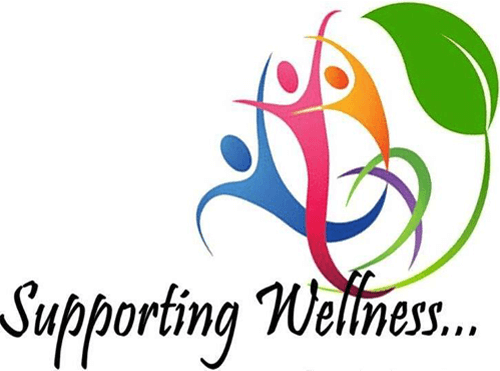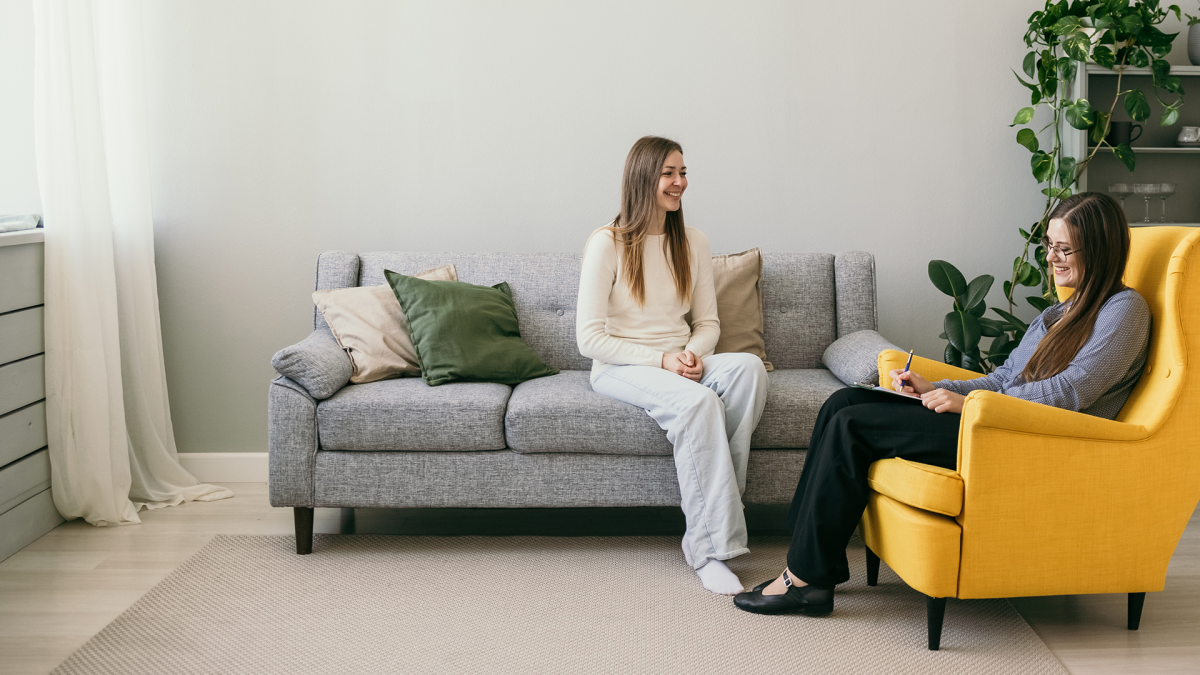By Rocio Maria Toledo, MC R.Psych
As human beings, we are social creatures. Not only does connection give us a sense of aliveness, but we are biologically wired to connect. Next time you are sitting in front of a person you sympathise with, listening to what they have to say, check both of your body postures and facial expressions, they will probably look incredibly similar. This is your biology naturally connecting without you even trying. We are born ready to securely attach to our main caregivers, to love them and be loved. As a species, we thrive in cooperation with others, regardless of how independent you might be or how much you might appreciate your alone time.
Given that we are inherently social beings, relationships are an important part of our life. Maintaining healthy relationships can be difficult. They take effort, intention, time, self-awareness and so much more.
Have you ever been in a relationship with someone you deeply cared about only to have the relationship not work out despite mutual love? Do you often experience anxiety, frustration, or anger in relationships? Have you noticed recurring patterns in your relationships that you are not necessarily proud of? Read on, you might learn something about yourself.
What is Attachment?
I believe it is imperative to discuss attachment when talking about relationships.
We all have attachment styles. Our attachment style informs the way in which we relate with others, with ourselves, with our needs, with our emotions, with our present moment, and with the world.
Dr. Diane Poole Heller defines attachment as adaptations we adopt early on in life to cope with the relational environment we grew up in. These adaptations aren’t typically stored in our conscious memory but are embedded in our bodies as part of our implicit/procedural memory. This explains why we sometimes may behave or feel in certain ways that do not make sense to us [1].
It is important to note that the purpose of these adaptations was to keep us emotionally, mentally, and physically safe. They made perfect sense at the time in which we adopted them. What we may realize as adults, is that these strategies are no longer serving us in the context of our new, adult relationships.
We know that our attachment style is mostly rooted in our early relationship with our main caregiver/s; however, it is also important to note that other significant relationships and experiences throughout life can also impact our attachment styles. There are also factors such as unavoidable separations between child and caregiver due to medical procedures or health issues, the child’s temperament, and environmental conditions that can play a role [1].
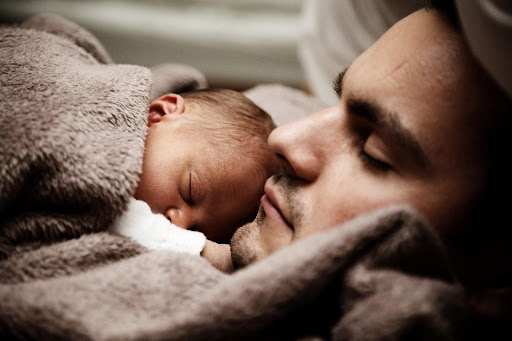
Let’s Explore the Different Attachment Styles
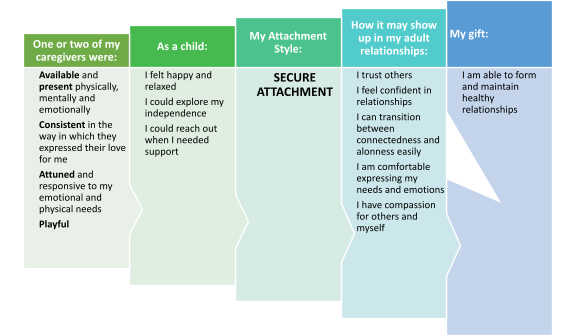
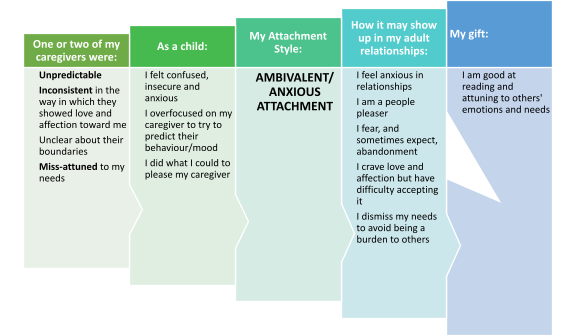
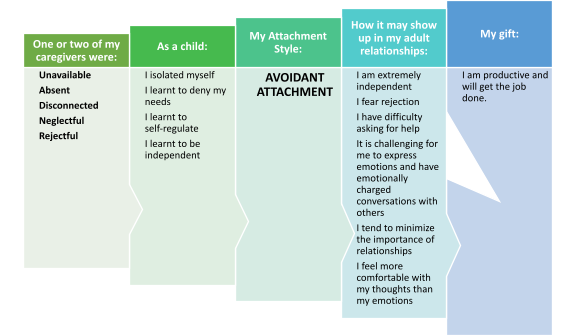
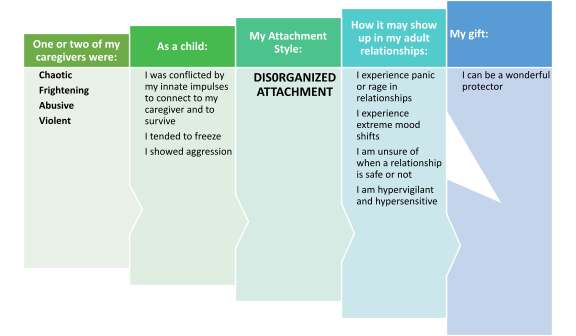
Now you might have identified yourself with one or more of the attachment styles explained. Here are a few things to keep in mind:
- We are complicated, so we typically have characteristics from more than one attachment style. What is your predominant attachment style? What adaptations tend to show up in your relationships?
- We all have the ability to securely attach, in other words, we all have the ability to feel secure within relationships. It is in our biology. We might just have to re-learn how to do it.
Moving Toward Secure Attachment
First of all: KNOW THIS IS POSSIBLE
What you do to move toward feeling secure within relationships and fostering healthy, long-lasting relationships will vary depending on what your predominant attachment style is, but here are some general guidelines to get you started:
- Explore your attachment style. If you are unsure about what your predominant attachment style is, you can try taking a free online questionnaire created by Dr. Diane Poole Heller [2].
- Explore potential links between your current attachment tendencies and past relationships and experiences to make sense of your experience.
- Practice kindness, understanding, and compassion for the “little you” who adopted these strategies. They helped you stay emotionally and physically safe at the time.
- If it is in you to do, foster compassion for your caregivers as they probably did what they could based on their own history and environmental circumstances at the time. If compassion does not show up, that is okay too.
- Fake it till you make it. Practice secure attachment (see what secure attachment looks like in the chart above). You may start by practicing awareness, validation, honouring, and expression of your own needs, emotions, and experiences.
- Strengthen your relationship with your present moment, your existing relationships, your current context. Practice intentionally responding to your present moment rather than reacting from the past.
- Notice when secure attachment shows up and intentionally focus on these experiences for longer by thinking about them, writing about them, re-telling them to someone else.
- Be okay with old patterns showing up at times, this will happen, and it doesn’t mean that you are back to square one in your journey toward secure attachment. This is part of the process. How many times have you unwittingly driven toward a previous home/work address, kid’s old school out of habit?
- Always engage in self-care by soothing yourself, listening to your needs, respecting your boundaries, experiencing joy, connecting with those who feel safe.
- Seek professional support to walk this journey and heal past attachment wounds.
I wish you an enlightening journey toward increased connection and authenticity, full of self-compassion and acceptance.
If you need help coming to terms with your attachment style, contact Supporting Wellness & Therapy in Calgary. We are here to help you.
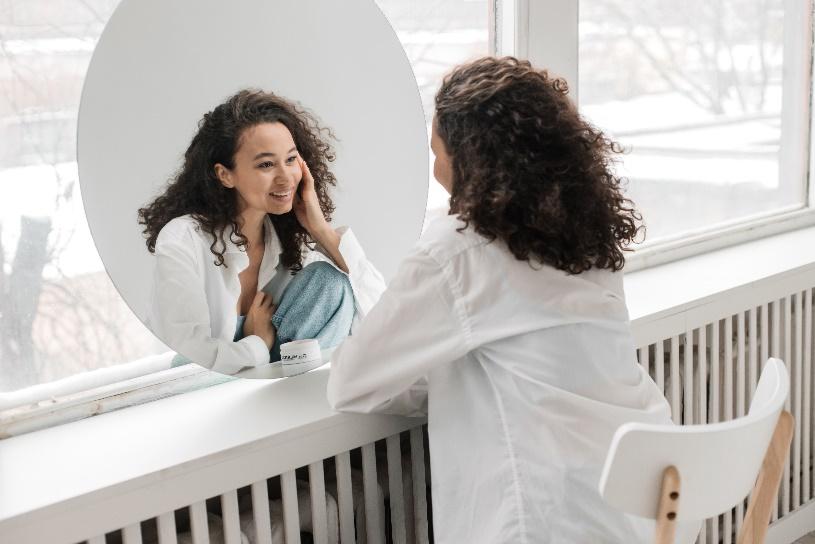
References
- Heller, D. P. (2019). The power of attachment: How to create deep and lasting intimate relationships. Sounds True.
Heller, D. P. Trauma Solutions, dianepooleheller.com, https://dianepooleheller.com/. Accessed 1 May 2022.
